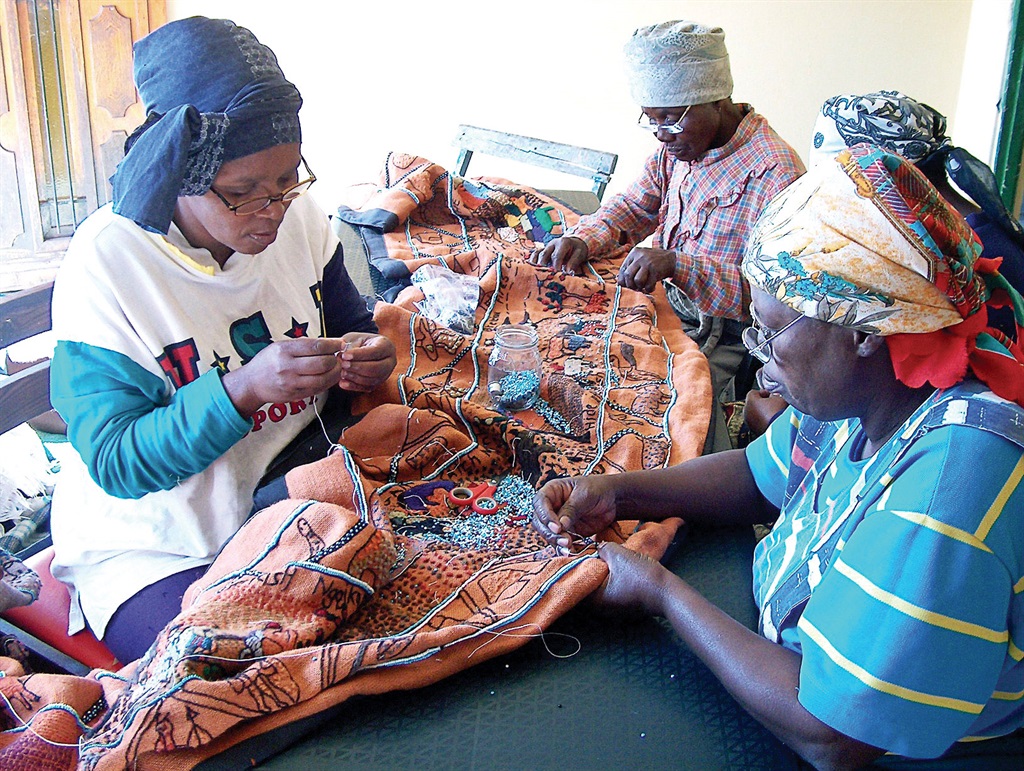
- Nozeti Makhubalo was forced to poach abalone to support her family and risked drowning and being arrested.
- That was until the Keiskamma Art Project transformed her life and that of the rural Eastern Cape community.
- Today, she is a master embroiderer, can earn a decent living and is happy and indepedent.
Hamburg is a small coastal village between East London and Port Alfred. Poverty levels there are so extreme that resident Nozeti Makhubalo was forced to poach abalone under the cover of darkness, running the risk of drowning and arrest to support her family.
"I'm not a criminal; I'm not a thief," she says. "But I had to poach to feed my kids – I didn't have any other choice." Her husband had been sent home from the mines after losing his eyesight, his hearing and some of his fingers – with zero compensation.
But that was before the Keiskamma Art Project transformed this rural Eastern Cape community. Today, Makhubalo holds her head up high as a master embroiderer and artist with the skills to earn a decent living. Since joining Dr Carol Hofmeyr's fledgling art project in 2000, she has become a dab hand at designing, drawing and embroidery, bringing gigantic tapestries to life.
Says Makhubalo:
READ MORE | SA Keiskamma Art Project now on display - 130 women impacted by HIV weave stories of pain and loss
Makhubalo has worked on 14 of the 15 major artworks in the project's retrospective exhibition, titled Umaf' Evuka, nje Ngenyanga/Dying and Rising, As the Moon Does, currently on until March 2023 at Constitution Hill. The artworks deal with themes that have healing, expressive and creative value to the Hamburg community – HIV/Aids, Covid-19, cultural practices and community life.
Dignity through visual storytelling
By telling their stories, the women of Hamburg have reclaimed their dignity, says Dr Hofmeyr. The Keiskamma Art Project has also given birth to other initiatives that have enriched the community – including a health project and a music academy.
Fluent in English, Afrikaans and isiXhosa, Cape Town resident Eunice Mangwane was persuaded to move to Hamburg to join Hofmeyr (a medical doctor and artist) as an interpreter on her trips to almost 50 clinics in the rural Eastern Cape. Mangwane subsequently worked her way up the ranks to coordinate 60-plus village health workers.
"HIV and Aids were on the rise in the early 2000s, and there was a desperate need for education," she relates. "For example, a certain clinic sister told me that people weren't dying from Aids – they were dying because they weren't performing rituals and slaughtering goats and cows."
READ MORE | 'It unboxed that talent I always had': How lockdown inspired Maggie to turn love of art into a business
There was clearly a need to counter such disinformation around the pandemic. Galvanised into action and inspired by the 16th-century Isenheim Altarpiece created by Matthias Grünewald, more than 100 Hamburg women worked for six months, designing and stitching the Keiskamma Altarpiece into being.
It stands today as a living memorial to those who died of Aids while celebrating the community's resilience. Says Mangwane:
The exhibition has also brought into sharp (and emotional) focus the "ups and downs, the pain and the joy that are palpable in the works" for co-curator Pippa Hetherington. Shipping 15 large-scale, multi-panel works – some more than 100m long – to Constitution Hill from collections around the world was a gargantuan feat but a true labour of love, she says.
From the rural Eastern Cape to the world
Hetherington, a documentary photographer, says the seed for the exhibition was planted when she was living in New York. "I'd walk into huge museums in the US and see how much dedication and care was taken with retrospectives there, and I'd imagine the huge Keiskamma pieces and how relevant they are in the world today.
"Considering the synergy with African American textile art, with women's voices and Black Lives Matter, I felt it would be the most eye-opening, incredible experience for people to immerse themselves in these artworks … but I wanted the retrospective to start on home soil."
She and co-curators Azu Nwagbogu and Cathy Stanley had time to put together the finer details of the exhibition during lockdown – but the expense and challenges associated with logistics, transport and insurance loomed large.
"The moment Hollard pledged its support to cover the transport and packing costs, we could put a date in our diary. We knew it was possible, and the dream could come true," Hetherington relates. "It was the pivotal moment of the project. It was a chance to take the project’s work out of NGO-speak and allow it to be seen as valued, valuable and influential artmaking in its own right." She adds:
Hollard's Brand Executive, Heidi Brauer, concurs. "This is just the most incredible project and a beautiful testament to the resilience of these women and their dedication to creating better futures for themselves, their community and South Africa."
Works of community
The Keiskamma artworks are truly "works of community," says Hofmeyr, with each embroiderer making a unique contribution and the end result being nothing short of "miraculous". This is partly because the communal activity of sitting together and creating art is incredibly healing, says Makhubalo. "In the studio, as we sit together, we share everything. We are a sort of a support group to each other," she says.
Adds Mangwane:
Keiskamma project manager Michaela Howse agrees that visual storytelling has immense healing value. "The art project is a family. It's one of the few means for people to earn an income – there aren't a lot of options in Hamburg.
"Creating art is about change. It's about giving people in an isolated rural community the sense of having a place in the world. We're living in Hamburg, but we're part of a global community – and the suffering people experience in a place like Hamburg is part of the human experience."
Now, with the exhibition being hosted at Constitution Hill, a living museum that tells the story of the nation's journey to democracy, the Keiskamma artists are thinking more about how justice and democracy play out in their daily lives – so stand by for their next embroidered masterpiece, inspired by the real-life stories they observe around them.
Hollard is running a monthly competition in which a member of the public can win a handcrafted creation by the Keiskamma artists – simply by posting a selfie at the exhibition on social media using #HollardKeiskamma, and tagging @HollardInsurance (Facebook) or @hollardgram (Instagram).
Hollard is also commissioning a new tapestry from the Keiskamma Art Project, and is inviting members of the public to email their uniquely South African story ideas for this to Keiskamma@hollard.co.za before 31 January 2023.




 Publications
Publications
 Partners
Partners















